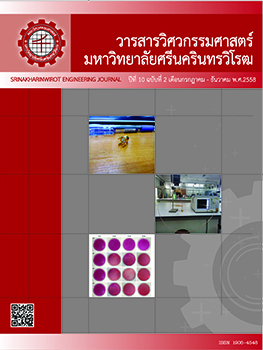การตรวจสอบการเจือปนของน้ำในน้ำผึ้งด้วยเซนเซอร์ตัวเก็บประจุไฟฟ้า แกนร่วม
Abstract
บทคัดย่อ บทความวิจัยนี้นำเสนอการตรวจสอบการปนเปื้อนของน้ำในน้ำผึ้งด้วยเซนเซอร์ตัวเก็บประจุไฟฟ้าแกนร่วม ระบบการตรวจสอบนี้ประกอบด้วย เซนเซอร์ตัวเก็บประจุไฟฟ้าแกนร่วม และเครื่องวิเคราะห์โครงข่ายแบบเวกเตอร์ จุดประสงค์ของเทคนิคนี้คือ การคำนวณหาค่าสภาพยอมทางไฟฟ้าสัมพัทธ์จากค่าสัมประสิทธิ์การสะท้อน ซึ่งเกิดจากเซนเซอร์สัมผัสตัวอย่างน้ำผึ้ง แล้วหาความสัมพันธ์ระหว่างค่าสภาพยอมทางไฟฟ้าสัมพัทธ์กับตัวอย่างน้ำผึ้งที่เจือปนด้วยน้ำ 0-20 % โดยน้ำหนัก ผลการทดลองแสดงให้เห็นว่า ณ สภาวะเดียวกัน (อุณหภูมิ 25 องศาเซลเซียส และความถี่ทางไฟฟ้า 0.5-3.0 กิกะเฮิรตซ์) ส่วนจินตภาพของค่าสภาพยอมทางไฟฟ้าสัมพัทธ์ของตัวอย่างน้ำผึ้งมีการเปลี่ยนแปลงไม่มากนักเมื่อน้ำผึ้งถูกเจือปนด้วยน้ำ 0-20 % โดยน้ำหนัก ซึ่งมีค่าอยู่ระหว่าง 6.5 และ 15 อย่างไรก็ตามส่วนจริงของค่าสภาพยอมทางไฟฟ้าสัมพัทธ์ของตัวอย่างน้ำผึ้งมีการเปลี่ยนแปลงอย่างมีนัยสำคัญที่สภาวะเดียวกัน ซึ่งมีค่าอยู่ระหว่าง 10 และ 45 นอกจากนั้น ณ ความถี่ 0.5 กิกะเฮิรตซ์ มีความเหมาะสมที่สุดที่จะนำมาใช้ในการตรวจสอบการเจือปนของน้ำในน้ำผึ้ง เนื่องจากว่า มีค่าอัตราการเปลี่ยนแปลงของค่าส่วนจริงต่อเปอร์เซ็นต์ของน้ำที่เจือปนในน้ำผึ้งสูงที่สุด คือ 1.25 ต่อ 1 เปอร์เซ็นต์ที่เปลี่ยนแปลง คำสำคัญ: น้ำผึ้ง เซนเซอร์ตรวจสอบการปนเปื้อน ค่าสภาพยอมทางไฟฟ้าสัมพัทธ์ ABSTRACT This research paper presents a detection technique for water adulteration in honey using coaxial capacitor sensor. The detection system consists of a coaxial capacitor sensor and a vector network analyzer. The objective of this technique is to calculate the relative electric permittivity from the reflection coefficient which is reflected when the sensor is immersed into the honey samples. After that, the relative electric permittivity is related to the honey samples with water adulteration in the range of 0-20% by weight and the temperature of 25°C. The experimental results showed that the imaginary part of the relative electric permittivity was not significantly changed for honey samples with water adulteration in the range of 0-20% by weight for the frequency range of 0.5-3.0 GHz. The values of imaginary part of the relative electric permittivity were between 6.5 and 15. However the real part of the relative electric permittivity was significantly changed for honey samples with water adulteration in the range of 0-20% by weight at the same condition. The values of real part of the relative electric permittivity were between 10 and 45. In addition, it would be most appropriate to detect the water adulteration in honey at the frequency of 0.5 GHz because the changing rate of real part to percent adulteration was the highest at 1.25 per 1 percent change. Keyword: Honey, Adulteration sensor, Relative electric permittivityDownloads
Download data is not yet available.
Downloads
Published
2016-01-29
Issue
Section
บทความวิจัย
License
ลิขสิทธิ์เป็นของวารสารวิศวกรรมศาสตร์ มหาวิทยาลัยศรีนครินทรวิโรฒ





